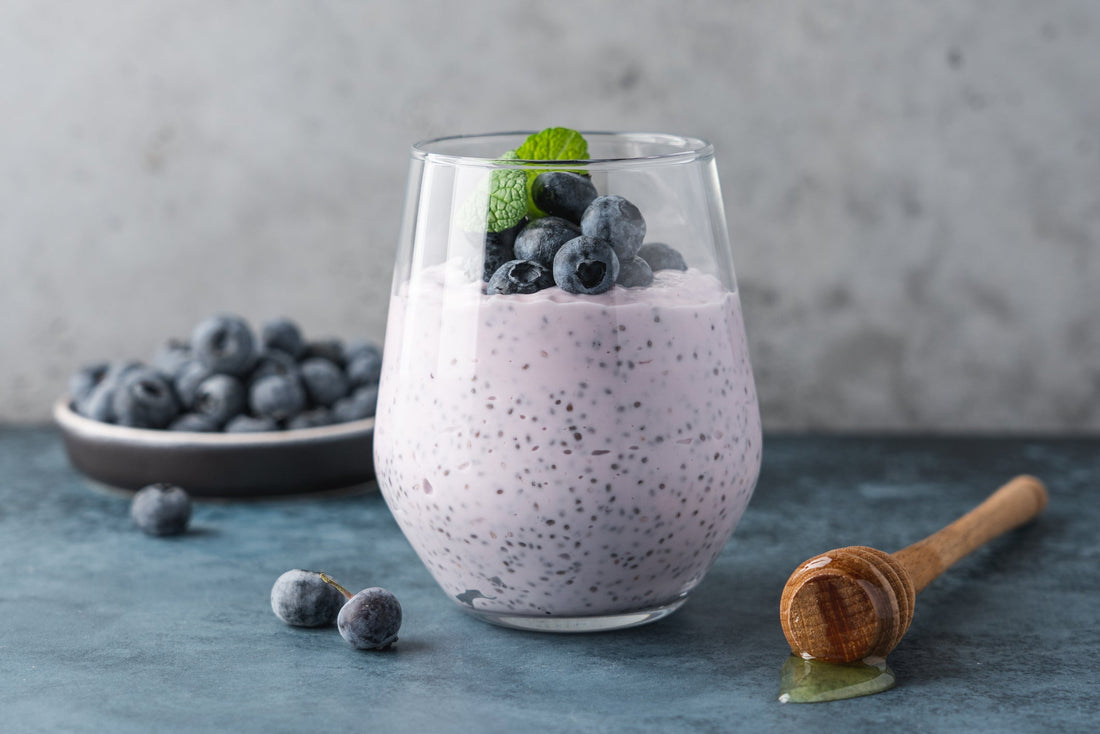
Chia Seeds: Fuel your cells
Share
Ever notice how some foods feel like more than just “fuel”? Chia seeds are one of those. These tiny black or white seeds, once prized by the Aztecs and Mayans, are now making a comeback as a modern-day superfood. And the science behind them is catching up in a big way.
Why Chia Seeds Are Worth Your Attention
At first glance, chia seeds don’t look like much. But spoon for spoon, they pack a powerful nutrient profile:
Omega-3 fatty acids (ALA): Plant-based fats linked to heart and brain health.
Fiber: Around 10 grams per ounce great for digestion, gut microbiome support, and satiety.
Protein: A complete plant protein containing all essential amino acids.
Micronutrients: Rich in calcium, magnesium, and antioxidants.
Here is an easy chia recipe to try :
Blended Chocolate Protein Chia Mousse.
-
high-protein (34 g) perfect as a post-workout meal or filling breakfast.
-
17 g of fiber excellent for gut health and satiety.
-
nutrient-dense, balanced meal — with carbs for energy, protein for muscle repair, and healthy fats for satiety & brain health.
(chia + protein + 1¼ cups milk + banana blended in)
-
Calories: 469 kcal
-
Protein: 34 g
-
Carbs: 42 g
-
Fiber: 17 g
-
Fat: 18 g
Ingredients (1–2 servings)
-
3 tbsp chia seeds
-
1¼ cups unsweetened almond milk (or any milk of choice)
-
1 scoop chocolate protein powder
-
1 tsp unsweetened cocoa powder (optional, for extra richness)
-
½ ripe banana
-
¼ cup blueberries
-
1 tbsp nuts (walnuts, almonds, or pecans), chopped
-
Pinch of cinnamon or sea salt (optional, enhances flavor)
Instructions
-
Blend the base: Add chia seeds, milk, protein powder, cocoa powder, and banana into a blender. Blend until completely smooth.
-
Chill: Pour into a jar or bowl and refrigerate for 1–2 hours (overnight for best results). The pudding will thicken as the blended chia gels.
-
Top & serve: Add blueberries, chopped nuts, and a sprinkle of cinnamon before eating.
Why You’ll Love This
Smooth, creamy texture (like chocolate mousse)
Easier digestion since chia seeds are broken down in the blender
Protein-packed & fiber-rich
Naturally sweet from banana & berries (no sugar needed)
What the Latest Research Says
Forget the hype let’s look at the science:
Metabolic health: A large 2024 study reviewing 835 people found that eating chia seeds regularly helped improve health markers related to weight, blood sugar, and metabolism (Pinto et al., 2024).
Blood pressure & body composition: Another 2024 review showed chia consumption could reduce both systolic and diastolic blood pressure and even trim waist circumference, though effects on overall body weight were modest (Abid et al., 2024; Lazo-de-la-Vega-Monroy et al., 2025).
Inflammation: Another study published in late 2024 found chia intake lowered inflammatory biomarkers, hinting at potential benefits for chronic disease prevention (Martínez-Huélamo et al., 2024).
Cardiometabolic protection: Comprehensive 2024 reviews highlighted chia’s role in improving vascular health, glycemic control, and lipid profiles in overweight populations (Silva et al., 2024; Zhu et al., 2024).
How to Use Chia Seeds (Safely)
Soak first: When dry, chia seeds absorb up to 12x their weight in liquid, which is why they make a gel. But eating them dry can cause discomfort or even choking. Always soak or mix them into yogurt, smoothies, or overnight oats.
Whole vs. ground: Whole seeds deliver plenty of fiber and satiety. Grinding (and eating soon after) makes omega-3s and proteins more bioavailable.
Daily dose: About 1–2 tablespoons (≈2.5 tbsp/day in studies) is enough to see benefits.
Motivation Station: Mindful Eating with Chia
Here’s how you can use chia seeds as your weekly “hero food” in the Motivation Station practice:
Choose it: Add chia seeds to breakfast oats, smoothies, or salads this week.
Anchor it: Each time you eat, think:
“These chia seeds are lowering inflammation in my body.”
“They’re helping my gut bacteria and protecting my heart.”
Reflect: Take a moment to notice how the food you just ate is nourishing your body. With every bite, you’re giving your cells what they need to thrive. Food isn’t just fuel it’s your daily medicine.
If you’d like to explore more about the health benefits of chia and discover a variety of delicious recipes, check out My Seeds Chia Test Kitchen. This book is packed with practical tips and has received excellent customer reviews. You can grab your copy on Amazon through my link, which takes you directly to the site.
Affiliate Disclosure:
As an Amazon Associate, I earn from qualifying purchases. This means that if you click on a link to a recommended product and make a purchase, I may receive a small commission at no extra cost to you. I only promote products I genuinely believe can benefit my readers. Thank you for supporting this blog—it helps me continue to provide valuable content on healthy ageing and wellbeing.
References
Abid, R., et al. (2024). Effects of chia seed supplementation on blood pressure and body composition: A systematic review and meta-analysis of randomized controlled trials. Clinical Therapeutics, 46(2), 210–222. https://doi.org/10.1016/j.clinthera.2024.11.005
Lazo-de-la-Vega-Monroy, M., et al. (2025). Chia seed supplementation and cardiometabolic outcomes: A dose–response meta-analysis. Nutrition Reviews, 83(3), 448–461. https://doi.org/10.1093/nutrit/nuaa123
Martínez-Huélamo, M., et al. (2024). Chia seed supplementation and inflammatory biomarkers: A systematic review and meta-analysis. Proceedings of the Nutrition Society, 83(4), 552–563. https://doi.org/10.1017/S2048679024000703
Pinto, A., et al. (2024). Effects of chia seed (Salvia hispanica L.) supplementation on obesity indices and metabolic factors: A systematic review and meta-analysis of RCTs. Nutrition Research, 109, 1–14. https://doi.org/10.1016/j.nutres.2024.101860
Silva, J., et al. (2024). Impact of chia seed intake on cardiometabolic health: A meta-analysis. Nutrition & Metabolism, 21(1), 54. https://doi.org/10.1186/s12986-024-00847-3
Zhu, L., et al. (2024). Chia seed consumption and cardiovascular health outcomes: Evidence from randomized trials. Food & Function, 15(2), 987–1002. https://doi.org/10.1039/D3FO02197A